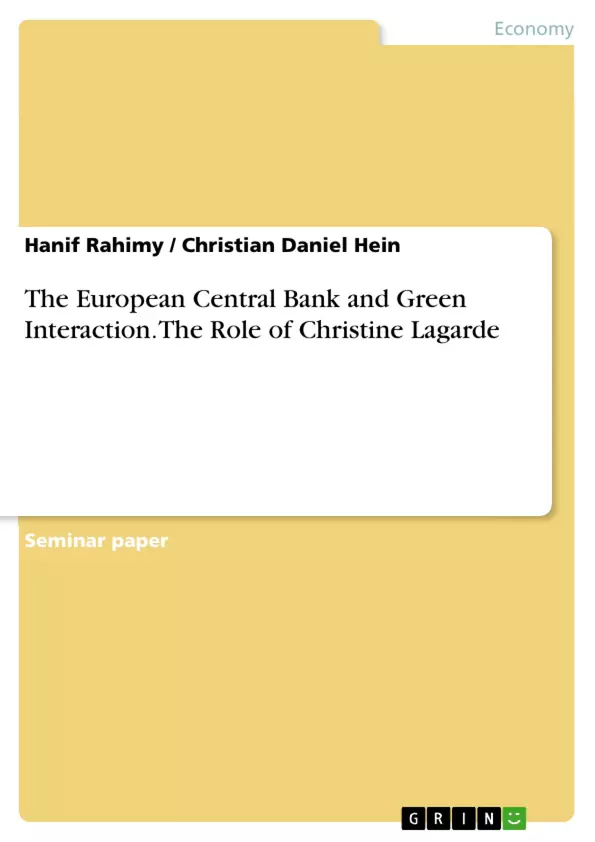This paper discusses the question, how Christine Lagarde wants to reorient the ECB's strategy and find answers to how the European Central Bank (ECB) could react to future developments such as climate change and if that is possible.
In 2015, 190 parties have committed themselves to the Paris Agreement. This agreement aims to limit global warming to well below 2 degrees. Climate change is one of the greatest challenges of our time and many nations have drawn up their own climate protection plans to limit their emissions. However, since climate change is a global challenge, international cooperation is more effective, if not necessary.
In December 2019, EU Commission President Ursula von der Leyen proved her commitment to environmental friendliness by announcing the European Green Deal in terms of which no more net greenhouse gas emissions are to be released in the EU by 2050. Von der Leyen is supported by the President of the European Central Bank (ECB) Christine Lagarde.
But does the ECB commit ultra vires in the process?
Inhaltsverzeichnis (Table of Contents)
- A. Introduction: Are environmental considerations part of the ECB's mandate?
- B. Green interaction and price stability.
- I. Institutional ECB law
- II. Economic theory behind price stability
- III. Objectives of the ECB
- 1. Price stability, Art. 127 para. 1 sentence 1 TFEU
- 2. Support of general economic policy, Art. 127 para. 1 sentence 2 TFEU
- a. Preliminaries
- b. Distinction between monetary and economic policy
- c. Application of the principle of proportionality
- 3. Principles underlying the objectives, Art. 127 para. 1 sentence 3 TFEU
- 4. Practical example
- IV. Programmes of the ECB
- 1. Outright Monetary Transactions
- 2. Asset Purchase Programmes
- a. Preliminaries
- b. Risks of the APP
- c. APPS in operation
- V. Areas of green interaction to be conducted by the ECB
- 1. Preliminaries
- 2. Advisory powers, Art. 4 and 6 ECB Statute
- 3. Financial stability and prudential supervision
- 4. Purchase of green bonds
- a. Purchase of green bonds within existing APPs
- b. New Green Bond Purchase Programme
- 5. Green money printing
- 6. Excursus: Regulation (EU) 2020/852 - Taxonomy
- VI. Comparison with other central banks
- 1. Preliminaries
- 2. Bank of England
- 3. The People's Bank of China
- C. Conclusion: Christine Lagarde intra vires!
Zielsetzung und Themenschwerpunkte (Objectives and Key Themes)
This paper examines the question of whether the European Central Bank (ECB) can and should pursue a "green" monetary policy under the leadership of Christine Lagarde. The paper analyzes the ECB's mandate, its recent programs, and its potential for green interaction.- The ECB's mandate and its interpretation by the institution itself.
- The potential for green interaction within the ECB's existing programs.
- The legal and economic feasibility of green monetary policy.
- Comparison with other central banks' approaches to climate change.
- The implications of Christine Lagarde's vision for the ECB's role in climate policy.
Zusammenfassung der Kapitel (Chapter Summaries)
- A. Introduction: Are environmental considerations part of the ECB's mandate? This chapter introduces the debate surrounding the ECB's potential role in climate change mitigation, highlighting Christine Lagarde's vision and the question of whether the ECB's mandate allows for such action.
- B. Green interaction and price stability. This chapter explores the institutional and economic framework of the ECB, including its mandate, objectives, and existing programs. It also examines potential areas for green interaction, such as advisory powers, financial stability, and green bond purchases.
- C. Conclusion: Christine Lagarde intra vires! This chapter (not included in the preview) will likely draw conclusions about the ECB's capacity to act on climate change, discussing the legal and economic feasibility of green monetary policy within the existing framework.
Schlüsselwörter (Keywords)
This paper focuses on the European Central Bank, its mandate, price stability, monetary policy, green monetary policy, climate change, green bonds, and the role of central banks in environmental policy.- Quote paper
- Hanif Rahimy (Author), Christian Daniel Hein (Author), 2020, The European Central Bank and Green Interaction. The Role of Christine Lagarde, Munich, GRIN Verlag, https://www.grin.com/document/1011962



